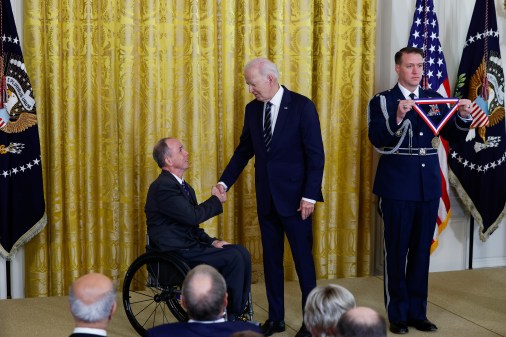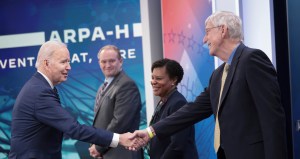Apple iWatch this. Google Glass that. Many of the hottest trends in the technology industry focus on the expanding Internet of Things and the wearable devices and sensors that power it. And within the federal government, while agencies haven’t yet reached a tipping point for the devices’ use, optimism for a future filled with wearables seems plentiful.
Of course, wearables are still in their infancy. But there’s plenty of belief from technology companies and federal innovators that they can create wearable solutions for government.
“We see ample opportunity for wearable technology to fit into the federal government landscape, particularly with field force workers,” Ferhan Hamid, CEO of INADEV, said. “In fact, we are in the early stages of working with a government agency on a pilot program examining the use of wearable technology.”
While Hamid didn’t disclose which agency was piloting that program, there’s countless obvious uses for wearables in the daily workflow of a civil servant.
“It’s easy to see use cases for wristbands incorporating bio-sensors for health monitoring and emergency signaling and for hands-free notification,” said Mark Cohn, chief technology officer for Unisys Federal Systems. “I think gesture control is looming big on the horizon and wearable input devices will be a significant element. That includes body, hand and finger motion at near proximity and room distance, eye motion and possibly others. Visual output devices like Google visors and Glass clearly have value for law enforcement and other missions’ situational awareness. Combining the two for the mobile worker on his or her feet is easy to visualize. “
Adam Dole, a presidential innovation fellow, said he “believe[s] that wearable technology has a major opportunity to play a big role in a few areas within [government].” Of his long list of possibilities, he mentioned:
- Public safety applications through wearable technologies that enhance communication and coordination;
- Medical breakthroughs using Google Glass, such as nano imaging and high throughput microscopy;
- Federal government efficiency, with agencies like the State Department using real-time translation and communication tools, Google Glass for digitizing manual paperwork in the Department of Veterans Affairs and biometric devices for high-security areas; and
- More apps and devices that use accelerometers to track and encourage federal worker productivity.
But that’s just scratching the surface. Plenty of agencies, from the Unites States Postal Service to the Federal Emergency Management Agency, can benefit from the enterprise possibilities of wearable technology, according to Brian Ballard, CEO of APX Labs, a Washington, D.C.-area company creating enterprise apps for smart glasses.
“I definitely see a role for wearables to play in the federal space. In fact it’s an enormous opportunity when you look at the number of people performing critical services in and around their communities,” Ballard wrote in an email. “Government employees handle logistics and mail delivery, infrastructure safety inspection, critical process and tasking, and disaster management…in fact these are all the same roles that are performed across other major verticals but happen to be in realm of public service.”
The federal government may have learned from its late adoption of other technologies in the past, Hamid said, not wanting to do the same this time around.
“With mobile devices, we saw massive adoption in the consumer space, and since then government has been playing a constant game of catch-up,” he said. “Now, many agencies are looking to get ahead of the wearable trend, which is critical given how fast these technologies develop and evolve.”
Agencies aren’t just concerned with internal productivity — many, such as the Food and Drug Administration and the Defense Advanced Research Projects Agency, are fostering wearable innovation in their respective verticals.
“We are excited about technology geared towards patient engagement and helping patients and consumers to stay healthy and fit,” said Jennifer Rodriguez, an FDA spokeswoman. “Wearable technologies have the potential to support this goal for a healthy state. In the mobile medical app guidance we have clarified that the FDA is focusing on a small subset of mobile apps that are medical devices and present a greater risk to patients if they do not work as intended.”
DARPA has several programs devoted to wearable-like technologies. For instance, its Warrior Web performance-improving suit and Urban Leader Tactical Response, Awareness and Visualization program are both developing wearable technologies that will improve the safety and performance of soldiers in combat.
But not everyone is so gung-ho for government wearables just yet. In a recent interview with FedScoop, Frank Schloendorn, director of quality assurance at MaaS360 by Fiberlink, a mobile company recently purchased by IBM, said government agencies, like the business sector overall, are going to face security and management obstacles that will prevent them from embracing the advent of wearables, at least in the near-term.
“It’s not technology that’s really enterprise-ready yet,“ Schloendorn said. “There’s not a consolidated system or way to manage it.”
Thus, the question seems not if a wearable explosion will happen, but when? Hamid, though, agrees with Schloendorn on the security battles the technology will face and said agencies need to start preparing now if they want to see wearables within the government soon.
“Agencies should start formally examining if wearable tech will help them see a return on their investment and realize meaningful efficiency gains,” he said. “They will also need to consider the security challenges that come along with wearable technologies; however, government has laid significant groundwork by addressing mobile security, which shares many of the same characteristics as wearables. “






